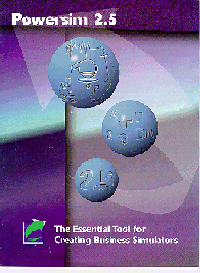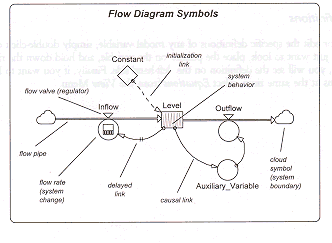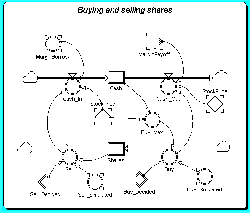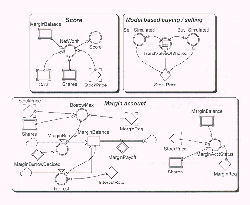Volume 10, Issue 2, 1996

Powersim
- Mike Emslie
- University of Bristol
Powersim takes its name from "Powerful Simulation". It's a simulation tool
based on the system dynamics methodology. This software package is designed to
enable the user to create complex business and economics simulations with the
powerful ability to run multiple "what-if" scenarios while varying the key
parameters under controlled conditions during run-time.
The real strength of a package such as Powersim, is two fold: Firstly, the ability to model a complex set of relationships. This very process of explicitly modelling aids the communication and understanding of these relationships by the student; Secondly, the model may be used for extensive experimentation which should also enable a deeper insight into the working of complex relationships by the student.
The ability to modify the parameters during run-time is a powerful way to aid understanding of the management of processes and has many applications in both macroeconomics, microeconomics, financial and management economics as well as in banking and foreign trade (as well as having application in many other disciplines).
Powersim is not new. It has been around for some time and in fact was an award winner in the 1994 EASA finals, what is new this time around, with this newly released version 2.5 is the addition of a number of features that enhance the package as a learning tool. The package now has full DDE and OLE capabilities, and can now integrate interactive video and sound into the business/economics simulators. There is an enhanced gallery of "Objects" for presenting Simulation Results - graphs, gauges, slider/bars buttons and number formatting.
Co-Modelling is now much easier - For complex models (an integrated European trade model for example) it is a simple task to partition the model in order that separate teams can build partial models that can be readily joined together. Models with upto 6,500 variables or array elements are feasible.
The extensive library of functions (156+) includes: financial, mathematical, statistical, control graphs, and historical functions which ease the performance of specialised computations.
The version that I have been able to review here briefly is the Powersim 2.5 Demo. This contains some eight examples of simulations of varying degrees of sophistication, these include: inventory; project management; product life cycle; urban population; and stock market analyses. The Demo package comes complete with a 42 page manual outlining the fundamentals of systems dynamics modelling including a simple example reproduced below showing the six basic model objects that are used to build a "model".

Figure 1: Flow Diagram Symbols
The Demo Models are briefly introduced and each are explained in turn in the manual. For each model the causal relationships are examined and explicitly displayed in a "Flow Diagram" constructed using the basic model objects. Displaying the outcome of the simulations in a way which is easy to assimilate is clearly aided by judicious use of graphs and tables. This is also well illustrated in the Demo manual.
The package is distributed on 5 diskettes and will run on any 80386 (or better) PC running Windows 3.X, NT or '95. I loaded it onto a Pentium running Windows 95 and onto a 486 notebook running Windows for Workgroups without any difficulty.
An important extra feature is the addition of a comprehensive on-line help system. This is much improved, and the "Quick Tour" in this version will guide the novice user from first principles to the intricacies of complex models with ease. Additional samples can be obtained from the Powersim World Wide Web Institute. Use the URL http://www.psiminst.com to learn more about Powersim; to download the additional models; and find out how to get hold of the software. One link worth following from the Powersim Institute is to the MIT "Systems Dynamics Learning Project" (http://sysdyn.mit.edu/) for those readers who wish to investigate further some of the educational implications of using this approach to teaching and learning. One of the primary tasks of the MIT Systems Dynamics group under the tutelage of Jay Forrester is the preparation of a set of "Road Maps" - in effect a series of 'guides' on how to learn the systems dynamics methodology. Some of this material is also available from their web site (cited above) but you will need to have the Adobe Acrobat Reader (distributed free - see the link at the MIT WWW site) in order to browse the material.
To return to the Powersim software we can illustrate some of the capabilities of this implementation of systems dynamics modelling by taking a look at the Stock Market simulation. This has been converted into a "Game". It is possible to play simply against the computer or against another participant on a network. Some of the parameters of the game are: Each player starts with $10,000 in cash; Neither player is capable of influencing the market price of he stock; Players are able to choose to use margin accounts; The margin account annual interest rate is (initially set at) 7%; the game is set for a full year of trading (250 days). The flow diagram is illustrated below.

Figure 2: Stock Market Game
Click on the image to see the full-size version
The flows that determine the game Scores, the Buy / Sell relationships and the Margin account are illustrated below.

Figure 3: Score; Buy/Sell; MarginClick on the image to see the full-size version
This provides the players with an excellent opportunity to explore fully the relationships modelled and to understand more fully the way in which these interrelationships produce the results that they do, and to seek insights into ways in which the interrelationships might be modified to shift the results in one direction or another.
This poses some interesting questions with respect to the feasibility of using this software in a teaching and learning context for economics. There are clearly advantages in encouraging the student to explore and understand relationships in both (say) macro and micro economic structures. There are significant overheads however, in learning the systems dynamics methodolgy, both for the student and the teacher in order to adequately exploit this approach to teaching and learning economics. Herein lies the difficulty that I have with this package for undergraduate teaching in mainstream economics or business, in view of the relatively sharp (but short) learning curve implied in order for this software to be effectively used.
Further information:
Powersim AS,Promenaden, Knarvik Senter
POBox 206
N-5100 Isdalsto,
Norway
Tel: +47-56-342400
Fax: +47-56-342401
E-mail: orders@powersim.no

